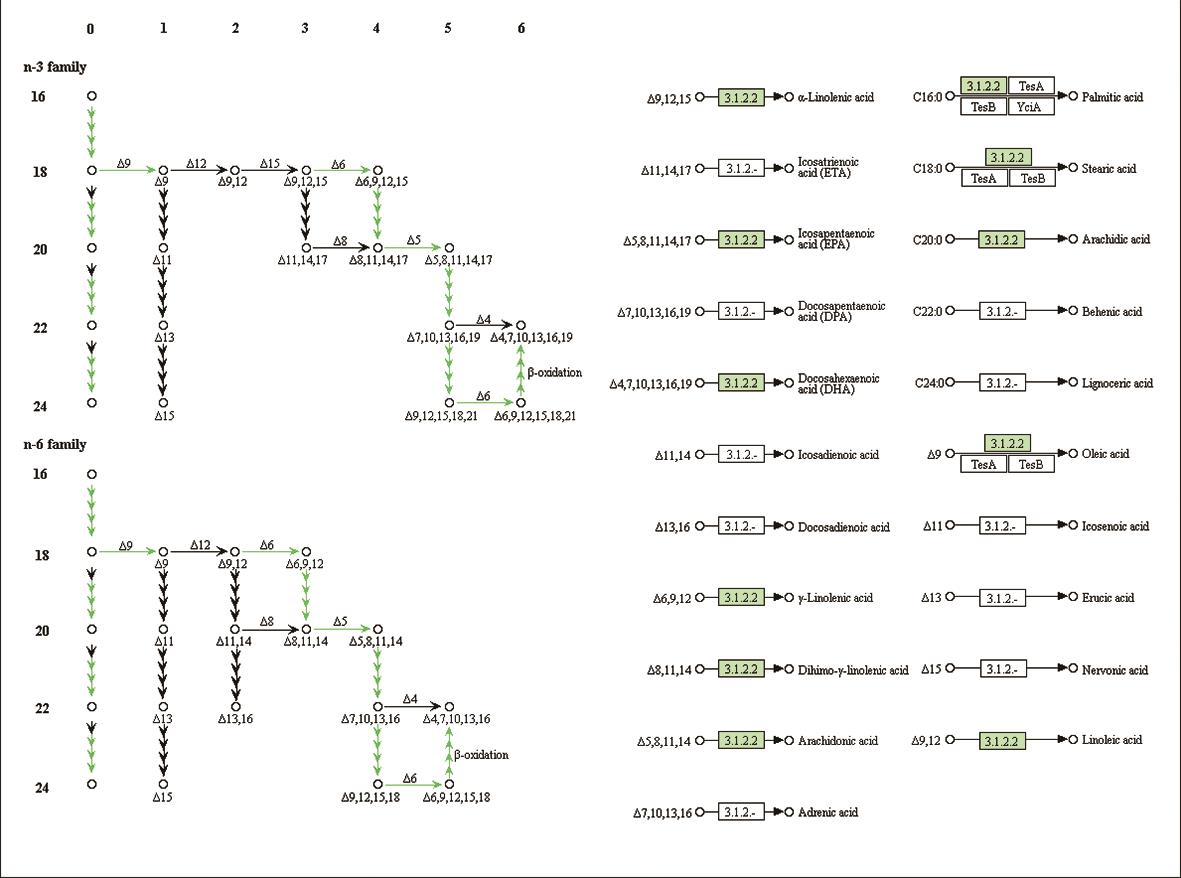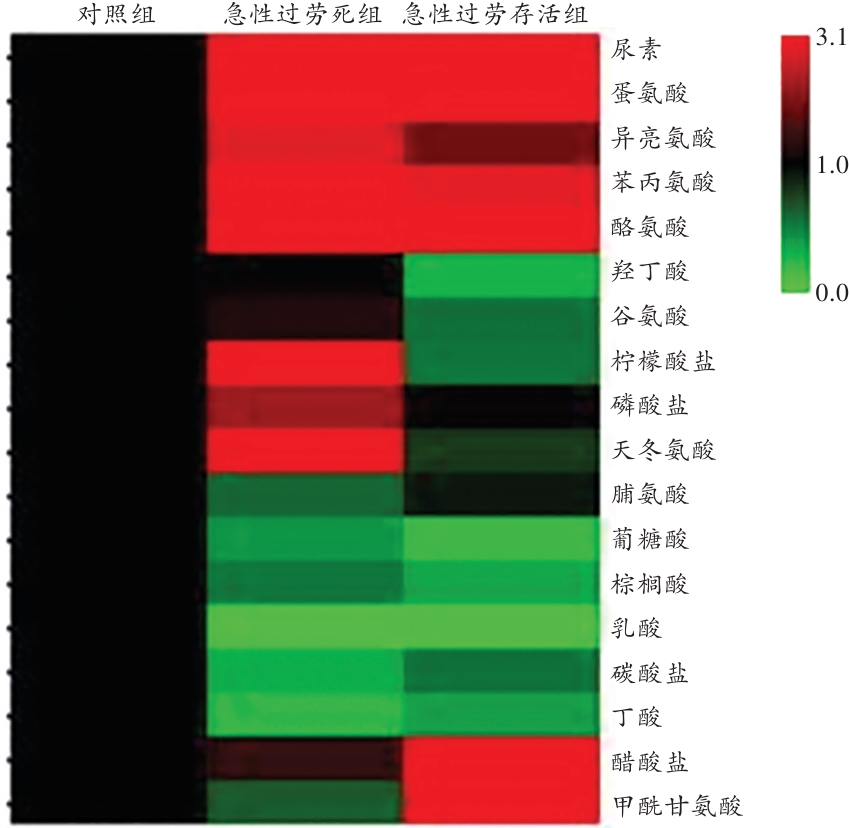

法医学杂志 ›› 2024, Vol. 40 ›› Issue (5): 439-446.DOI: 10.12116/j.issn.1004-5619.2022.421007
刘霞1,2( ), 李嘉敏1,3, 郑永霞1,4, 肖旭东1, 于晓军1(
), 李嘉敏1,3, 郑永霞1,4, 肖旭东1, 于晓军1( )
)
收稿日期:2022-10-28
发布日期:2025-02-11
出版日期:2024-10-25
通讯作者:
于晓军
作者简介:刘霞(1997—),女,硕士研究生,主要从事法医病理学和法医临床学科研及鉴定;E-mail:1050077962@qq.com
基金资助:
Xia LIU1,2( ), Jia-min LI1,3, Yong-xia ZHENG1,4, Xu-dong XIAO1, Xiao-jun YU1(
), Jia-min LI1,3, Yong-xia ZHENG1,4, Xu-dong XIAO1, Xiao-jun YU1( )
)
Received:2022-10-28
Online:2025-02-11
Published:2024-10-25
Contact:
Xiao-jun YU
摘要:
目的 探讨急性过劳死的发生和死亡机制及其法医学鉴定。 方法 将SD大鼠随机分为对照组15只和实验组45只(急性过劳死组、过劳存活组),建立负重力竭游泳合并睡眠剥夺的重度疲劳模型,记录行为、饮食、体质量、呼吸、心电图、超声心动图观察生理功能。死后解剖取材,HE染色观察病理形态,GC-MS检测血清、心肌、肝物质代谢的变化。 结果 实验组大鼠死亡率达33.3%。心肌中氨基丁酸、花生四烯酸含量降低;血清中尿素含量降低,蛋氨酸和苯丙氨酸含量升高;肝组织中,组氨酸等氨基酸含量升高;血生化丙氨酸转氨酶、天冬氨酸转氨酶、肌酸激酶、肌酸激酶同工酶等升高,葡萄糖和尿酸降低;血清及心、肝组织等能量代谢通路扰动;3 d后实验组大鼠出现心电传导阻滞、室性心律失常。急性过劳死组大鼠出现心室颤动和扑动;超声心动图示射血分数、左心室短轴缩短率下降;心肌颗粒性肿胀、肌质凝集,脑干暗神经元增多;血清尿素、蛋氨酸、苯丙氨酸差异代谢物变化的组合与过劳高度相关,确诊率达90.6%。 结论 急性过劳死可引发多器官代谢-功能-形态联动性变化,死亡机制可能为全身多器官功能失调,特别是中枢性衰竭和心脏性猝死。
中图分类号:
刘霞, 李嘉敏, 郑永霞, 肖旭东, 于晓军. 大鼠急性过劳死模型的建立及其代谢-功能-形态学变化[J]. 法医学杂志, 2024, 40(5): 439-446.
Xia LIU, Jia-min LI, Yong-xia ZHENG, Xu-dong XIAO, Xiao-jun YU. Establishment of an Acute Karoshi Rat Model and Its Metabolic, Functional and Morphological Changes[J]. Journal of Forensic Medicine, 2024, 40(5): 439-446.
| 组别 | n | 实验前 | 实验第7天 |
|---|---|---|---|
| 对照 | 15 | 297.56±8.50 | 315.11±14.95 |
| 急性过劳死 | 15 | 295.67±9.04 | 273.93±11.071) |
| 过劳存活 | 30 | 294.80±5.96 | 275.10±7.811) |
表1 各组大鼠实验前后的体质量变化 (x¯±s,g)
Tab. 1 Weight changes of rats in each groupbefore and after the experiment
| 组别 | n | 实验前 | 实验第7天 |
|---|---|---|---|
| 对照 | 15 | 297.56±8.50 | 315.11±14.95 |
| 急性过劳死 | 15 | 295.67±9.04 | 273.93±11.071) |
| 过劳存活 | 30 | 294.80±5.96 | 275.10±7.811) |
| 指标 | 对照组 | 实验第3天 | 实验第5天 |
|---|---|---|---|
| 射血分数/% | 87.67±7.51 | 67.54±9.521) | 56.11±8.411) |
| 左心室短轴缩短率/% | 58.23±5.32 | 36.09±7.141) | 29.21±5.631) |
| 舒张末期左心室质量指数/(g·m-2) | 774.76±14.37 | 788.67±21.861) | 809.96±68.391) |
| 收缩期左心室容积/μL | 19.41±2.37 | 23.70±4.921) | 42.80±6.781) |
表2 各组大鼠超声心动图数据统计 (n=5,x¯±s)
Tab. 2 Echocardiography data of rats in each group
| 指标 | 对照组 | 实验第3天 | 实验第5天 |
|---|---|---|---|
| 射血分数/% | 87.67±7.51 | 67.54±9.521) | 56.11±8.411) |
| 左心室短轴缩短率/% | 58.23±5.32 | 36.09±7.141) | 29.21±5.631) |
| 舒张末期左心室质量指数/(g·m-2) | 774.76±14.37 | 788.67±21.861) | 809.96±68.391) |
| 收缩期左心室容积/μL | 19.41±2.37 | 23.70±4.921) | 42.80±6.781) |
| 指标 | 对照组 | 急性过劳死组 | 过劳存活组 |
|---|---|---|---|
| 丙氨酸转氨酶/(U·L-1) | 38.20±4.97 | 92.20±3.961) | 88.00±6.481) |
| 天冬氨酸转氨酶/(U·L-1) | 79.20±4.32 | 346.00±47.601) | 239.80±21.941) |
| 丙氨酸转氨酶/天冬氨酸转氨酶 | 0.48±0.07 | 0.27±0.041) | 0.37±0.021) |
| C反应蛋白/(mg·L-1) | 0.38±0.19 | 0.40±0.20 | 0.44±0.19 |
| 尿素/(mmol·L-1) | 2.16±0.56 | 18.77±3.141) | 17.03±5.381) |
| 尿酸/(μmol·L-1) | 285.00±132.86 | 194.20±14.171) | 163.00±23.891) |
| 葡萄糖/(mmol·L-1) | 10.68±0.74 | 8.57±0.471) | 7.86±0.601) |
| 肌酸激酶/(U·L-1) | 809.40±38.05 | 4 604.20±230.261) | 5 866.40±263.141) |
| 肌酸激酶同工酶/(U·L-1) | 118.20±7.66 | 452.40±110.231) | 710.80±21.151) |
| 乳酸脱氢酶/(U·L-1) | 316.00±56.05 | 686.20±25.361) | 757.40±154.281) |
表3 各组大鼠血清生化指标 (n=8,x¯±s)
Tab. 3 Serum biochemical indexes of rats in each group
| 指标 | 对照组 | 急性过劳死组 | 过劳存活组 |
|---|---|---|---|
| 丙氨酸转氨酶/(U·L-1) | 38.20±4.97 | 92.20±3.961) | 88.00±6.481) |
| 天冬氨酸转氨酶/(U·L-1) | 79.20±4.32 | 346.00±47.601) | 239.80±21.941) |
| 丙氨酸转氨酶/天冬氨酸转氨酶 | 0.48±0.07 | 0.27±0.041) | 0.37±0.021) |
| C反应蛋白/(mg·L-1) | 0.38±0.19 | 0.40±0.20 | 0.44±0.19 |
| 尿素/(mmol·L-1) | 2.16±0.56 | 18.77±3.141) | 17.03±5.381) |
| 尿酸/(μmol·L-1) | 285.00±132.86 | 194.20±14.171) | 163.00±23.891) |
| 葡萄糖/(mmol·L-1) | 10.68±0.74 | 8.57±0.471) | 7.86±0.601) |
| 肌酸激酶/(U·L-1) | 809.40±38.05 | 4 604.20±230.261) | 5 866.40±263.141) |
| 肌酸激酶同工酶/(U·L-1) | 118.20±7.66 | 452.40±110.231) | 710.80±21.151) |
| 乳酸脱氢酶/(U·L-1) | 316.00±56.05 | 686.20±25.361) | 757.40±154.281) |

图4 心肌部分代谢通路图左侧纵向数字代表碳原子个数,横向数字代表双键数量,方框内数字代表EC编号[酶学委员会(Enzyme Commission)为酶所制作的一套编号分类方法]。圆圈代表代谢物。带箭头的线条:绿色代表通路激活的方向(产物多于代谢物),黑色代表通路未激活。
Fig. 4 Partial metabolic pathway diagram of myocardium

图6 血清中16种具相同趋势的共同差异脂质的热图图中同一列代表同一组平均值比例,同一行代表同一差异代谢物。每一行代表某种代谢物的平均值在该组中与相应对照组的比例,不同颜色代表不同比例。绿色代表该样品中该物质在该组的相对含量比对照组低,反之,红色代表高。
Fig. 6 Heat map of 16 common differential lipidswith the same trend in serum
| 1 | SHAN H P, YANG X H, ZHAN X L, et al. Overwork is a silent killer of Chinese doctors: A review of Karoshi in China 2013—2015[J]. Public Health,2017,147:98-100. doi:10.1016/j.puhe.2017.02.014 . |
| 2 | YANG C, CHEN Z L, CHEN L Y. Overwork-induced sudden death: A sword of damocles hanging over Chinese medical staff[J]. Iran J Public Health,2020,49(2):392-393. |
| 3 | 朱煜. 新冠疫情中工伤认定问题的法律探析[J].喀什大学学报,2021,42(2):34-37,44. doi:10.13933/j.cnki.2096-2134.2021.02.07 . |
| ZHU Y. Legal analysis on the identification of work-related injuries in COVID-19 epidemic[J]. Kashi Daxue Xuebao,2021,42(2):34-37,44. | |
| 4 | 杜星慧. 劳动过程视角下程序员过劳问题研究及对社会工作介入的启示——以某市A互联网公司为例[D].北京:首都经济贸易大学,2020. |
| DU X H. Research on Programmer overwork from the perspective of labor process and its implications for social work intervention — A case study of A Internet company[D]. Beijing: Capital University of Economics and Business,2020. | |
| 5 | YANG Z C, YANG B, LI J. Perspectives on compensation and legislation of death due to work overload — Karoshi[J]. QJM,2015,108(4):349-350. doi:10.1093/qjmed/hcu207 . |
| 6 | YANG C, CHEN Z L, CHEN L Y, et al. Burnout in healthcare: A sign of death by overwork for doctors in China[J]. BMJ,2019,366:l5582. doi:10.1136/bmj.l5582 . |
| 7 | 孙传玲. 我国“过劳死”工伤认定问题研究[D].南宁:广西大学,2017. |
| SUN C L. The research on Karoshi identification of work-related injury[D]. Nanning: Guangxi University,2017. | |
| 8 | 杨博帆,史婧卓,李晶,等. 大鼠过劳模型心脏Cx43和Cx45的表达[J].法医学杂志,2019,35(5):567-571. doi:10.12116/j.issn.1004-5619.2019.05.010 . |
| YANG B F, SHI J Z, LI J, et al. Expression of Cx43 and Cx45 in cardiomyocytes of an overworked rat model[J]. Fayixue Zazhi,2019,35(5):567-571. | |
| 9 | XIAO N, YANG B F, SHI J Z, et al. Karoshi may be a consequence of overwork-related malignant arrhythmia[J]. Med Sci Monit,2019,25:357-364. doi:10.12659/MSM.911685 . |
| 10 | 徐文,钱钰,殷劲. 过度疲劳状态模型大鼠心脏功能及心肌细胞凋亡调控因子的变化[J].中国组织工程研究,2019,23(19):3074-3079. doi:10.3969/j.issn.2095-4344.1253 . |
| XU W, QIAN Y, YIN J. Changes of cardiac function and myocardial apoptosis regulatory factors in rat models of excessive fatigue[J]. Zhongguo Zuzhi Gongcheng Yanjiu,2019,23(19):3074-3079. | |
| 11 | 靳思楠. 我国“过劳死”工伤认定问题立法研究[D].上海:上海师范大学,2021. |
| JIN S N. Legislative research on the identification of work-related injury caused by overwork in China[D]. Shanghai: Shanghai Normal University,2021. | |
| 12 | 杨博帆,史婧卓,李倩璟. 过劳死的概念、现状及法医病理学思考[J].法医学杂志,2019,35(4):455-458. doi:10.12116/j.issn.1004-5619.2019.04.015 . |
| YANG B F, SHI J Z, LI Q J. The concept, current situation, and forensic pathological thinking of death from overexertion[J]. Fayixue Zazhi,2019,35(4):455-458. | |
| 13 | 李玉萍,黄少惠,靳文. 疲劳型亚健康大鼠模型的构建[J].中国组织工程研究,2012,16(7):1225-1228. doi:10.3969/j.issn.1673-8225.2012.07.020 . |
| LI Y P, HUANG S H, JIN W. Construction of a sub-health fatigue rat model[J]. Zhongguo Zuzhi Gongcheng Yanjiu,2012,16(7):1225-1228. | |
| 14 | 刘睿,郝云涛,乌兰,等. 核桃低聚肽对亚健康疲劳大鼠的影响[J].中国食物与营养,2019,25(12):59-64. doi:10.19870/j.cnki.11-3716/ts.2019.12.012 . |
| LIU R, HAO Y T, WU L, et al. Effect of walnut oligopeptide on sub-health fatigue rats[J]. Zhongguo Shiwu Yu Yingyang,2019,25(12):59-64. | |
| 15 | MIZOKAWA S, TANAKA M, MATSUMURA A, et al. Recovery from fatigue: Changes in local brain 2-[18F]fluoro-2-deoxy-D-glucose utilization measured by autoradiography and in brain monoamine levels of rat[J]. Neurosci Lett,2003,353(3):169-172. doi:10.1016/j.neulet.2003.09.040 . |
| 16 | ZHANG W, ZHANG W, DAI N, et al. A rat model of central fatigue using a modified multiple platform method[J]. J Vis Exp,2018,138:57362. doi:10.3791/57362 . |
| 17 | 王纯雨. 大鼠力竭性运动后不同时相心肌结构及心电图动态变化的研究[D].济南:山东师范大学,2010. |
| WANG C Y. Study on dynamic changes of myocardial structure and electrocardiogram at different stages after exhaustive exercise in rats[D]. Jinan: Shandong Normal University,2010. | |
| 18 | MURATSUBAKI T, HATTORI T, LI J, et al. Relationship between job stress and hypo-high-density lipoproteinemia of Chinese workers in Shanghai: The Rosai Karoshi study[J]. Chin Med J (Engl),2016,129(20):2409-2415. doi:10.4103/0366-6999.191750 . |
| 19 | ROWE W J. Extraordinary unremitting endurance exercise and permanent injury to normal heart[J]. Lancet,1992,340(8821):712-714. doi:10.1016/0140-6736(92)92243-9 . |
| 20 | ZHONG Z, JONES S, THURMAN R G. Glycine minimizes reperfusion injury in a low-flow, reflow liver perfusion model in the rat[J]. Am J Physiol,1996,270(2 Pt 1):G332-G338. doi:10.1152/ajpgi.1996 . |
| 270 | 2.G332. |
| 21 | 查锡良,药立波. 生物化学与分子生物学[M]. 8版. 北京: 人民卫生出版社,2013:212-213. |
| ZHA X L, YAO L B. Biochemistry and molecular biology[M]. 8th ed. Beijing: People’s Medical Publishing House,2013:212-213. | |
| 22 | 曲静,陈祖学. 大学生运动员过度训练的诊断及其防治[J].科技视界,2012(24):127-128,384. doi:10.19694/j.cnki.issn2095-2457.2012.24.052 . |
| QU J, CHEN Z X. Diagnosis and prevention of overtraining of college athletes[J]. Keji Shijie,2012(24):127-128,384. | |
| 23 | 乔伋. 急性体力负荷过度[J].冰雪运动,1981,3(12):27-30,24. |
| QIAO J. Acute physical overload[J]. Bingxue Yundong,1981,3(12):27-30,24. | |
| 24 | LEHMANN M J, LORMES W, OPITZ-GRESS A, et al. Training and overtraining: An overview and experimental results in endurance sports[J]. J Sports Med Phys Fitness,1997,37(1):7-17. |
| 25 | 房芳. 过度训练后大鼠心肌损伤及磷酸肌酸钠对其影响的研究[D].石家庄:河北师范大学,2008. |
| FANG F. Study on myocardial injury after overtraining in rats and the effect of creatine phosphate sodium on it[D]. Shijiazhuang: Hebei Normal University,2008. | |
| 26 | 田中,康凯. 过度训练的生化诊断[J].山东体育科技,2001,23(3):27-28. doi:10.14105/j.cnki.1009-9840.2001.03.011 . |
| TIAN Z, KANG K. Biochemical diagnosis of overtraining[J]. Shandong Tiyu Keji,2001,23(3):27-28. | |
| 27 | 何婷. 耐力性运动员超声心动图及心率变异性特征的实验研究[D].西安:西安体育学院,2013. |
| HE T. Experimental study on the characteristics of echocardiography and heart rate variability of endurance athletes[D]. Xi’an: Xi’an Physical Education University,2013. | |
| 28 | LUO J M, CHEN G, WEI L, et al. Severe diffuse axon injury in chronic alcoholic rat medulla oblongata following a concussion blow[J]. Alcohol Alcohol,2014,49(3):231-237. doi:10.1093/alcalc/agu009 . |
| 29 | 李雪,袁琼嘉,熊若虹,等. 过度训练大鼠大脑微血管超微结构和三维构筑变化[J].中国运动医学杂志,2007,26(2):219-221,241. doi:10.16038/j.1000-6710.2007.02.023 . |
| LI X, YUAN Q J, XIONG R H, et al. Changes of ultrastructure and three-dimensional architecture of cerebral microvascular in overtraining rats[J]. Zhongguo Yundong Yixue Zazhi,2007,26(2):219-221,241. | |
| 30 | 毛彦辉,于晓军,王海鹏,等. 脑-颈髓轴索损伤的解剖和取材新方法及其应用[J].中国法医学杂志,2020,35(6):642-646. doi:10.13618/j.issn.1001-5728.2020.06.017 . |
| MAO Y H, YU X J, WANG H P, et al. A new method of anatomy and sampling of brain-cervical spinal cord axonal injury and its application[J]. Zhongguo Fayixue Zazhi,2020,35(6):642-646. |
| [1] | 严赫, 冯向阳, 万贝贝, 黄飞骏, 张乐. 慢性阻塞性肺疾病合并气道侵袭性曲霉病致死1例[J]. 法医学杂志, 2024, 40(5): 512-515. |
| [2] | 刘会, 张飞龙, 漆利民, 朱承仁, 郑剑. 水牛攻击致死法医学鉴定1例[J]. 法医学杂志, 2024, 40(5): 509-511. |
| [3] | 宋国铭, 陈积峰, 盛利. 砍切颈项部自伤分析1例[J]. 法医学杂志, 2024, 40(5): 506-508. |
| [4] | 董贺文, 田志岭, 凡润杰, 赵亮, 顾钰奇, 刘宇铭. 扼勒颈部致机械性窒息死亡后焚尸1例[J]. 法医学杂志, 2024, 40(5): 504-506. |
| [5] | 韩祺瑞, 张文骥, 李昊洋, 罗颖超. 血迹遗留时间推断技术现状与展望[J]. 法医学杂志, 2024, 40(5): 468-475. |
| [6] | 郑欣, 邱越, 李志刚, 向青青, 汪冠三, 石河, 徐曲毅, 隋鹏, 马雁兵, 刘超, 陈立方, 赵建. 基于细菌群落鉴别裸鼠生前损伤和死后损伤[J]. 法医学杂志, 2024, 40(5): 430-438. |
| [7] | 王启团, 接存正, 王莹莹, 韩笑. 扼颈后出血性脑梗死迟发死亡1例[J]. 法医学杂志, 2024, 40(4): 394-396. |
| [8] | 贾梦洋, 刘之江, 董贺文, 张建华, 李正东. 盆腔脓肿腹腔镜术后脓毒性休克死亡1例[J]. 法医学杂志, 2024, 40(4): 391-393. |
| [9] | 李霁伦, 罗超, 范颖, 汪家文, 张建华. 20例泌尿外科死亡案例的医疗损害鉴定结果分析[J]. 法医学杂志, 2024, 40(4): 359-364. |
| [10] | 吴妍娟, 章青波, 王英元, 孙俊红. 肝门静脉血栓栓塞行TIPS后肝破裂出血死亡1例[J]. 法医学杂志, 2024, 40(4): 400-403. |
| [11] | 郭文青, 陈敏, 马骜, 黄平, 张吉. 蛋白酶-过氧化氢消解法在法医学硅藻检验中的应用[J]. 法医学杂志, 2024, 40(4): 317-323. |
| [12] | 殷雯婷, 沈恂怡, 马士东. 食管癌术中奇静脉破裂出血致死医疗损害1例[J]. 法医学杂志, 2024, 40(4): 397-399. |
| [13] | 王建峰, 杨琛腾, 张国忠, 丛斌. 脑心综合征研究进展及其法医学意义[J]. 法医学杂志, 2024, 40(4): 372-378. |
| [14] | 李艳红, 许小明, 熊思齐, 刘世奇, 熊小亮. 右冠状动脉扩张并血栓形成猝死1例[J]. 法医学杂志, 2024, 40(3): 291-292. |
| [15] | 方伟, 郑吉龙, 付奕铭, 刘轶. 利用犬类嗅觉搜索人体遗骸研究进展[J]. 法医学杂志, 2024, 40(3): 269-275. |
| 阅读次数 | ||||||
|
全文 |
|
|||||
|
摘要 |
|
|||||